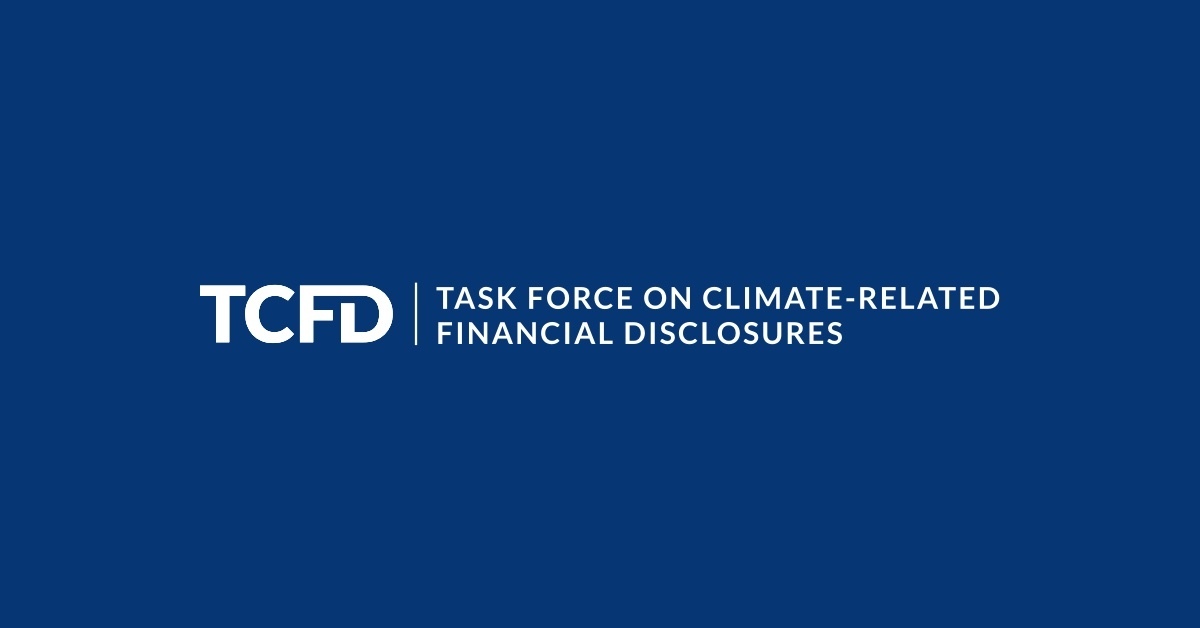TCFD 101: Reporting Climate Risks
Breakdown what the Task Force on Climate-related Financial Disclosures covers and when to use these guidelines

WHAT IS THE TASK FORCE ON CLIMATE-RELATED FINANCIAL DISCLOSURES?
Climate reporting remains a nascent, yet dense space. It can be challenging to decipher what’s needed and what’s a nice-to-have. For example, the Task Force on Climate-related Financial Disclosures, or TCFD.
TCFD helps companies disclose not just their financial risks related to climate change impacts, but also the opportunities that exist to support informed decision-making in the face of a changing environment.
But why is this something a business would want to undertake? And how can it support other climate reporting needs, like SBTI Targets or CDP reporting?
We sat down with Charlie Quann, Head of Corporate Reporting and Decarbonization at Planet FWD, to get a better understanding of these guidelines and how they can help businesses assess risks and opportunities.
WHY DOES TCFD MATTER?
Charlie: As we pivot to a low-carbon economy and as we try to adapt to a changing environment, a lot of folks out there view the climate crisis as just costs and risks. But the fact of the matter is that there are significant business opportunities that exist as well, such as job development or new products and services.
TCFD is a framework by which companies can assess those risks and opportunities. These analyses are used internally to inform decision-making on business operations while external teams use it to assess what a company is doing, can do, and how they're thinking about climate change.
For example, large institutional investors are not necessarily going to pick up the phone and call these businesses to discuss the minute details of their climate strategies. However, they are likely to evaluate publicly disclosed TCFD information around the risks and opportunities that are specific to that business.

Rachel: Why would a company want to create SBTi-aligned goals and complete TCFD reporting?
Charlie: With SBTi targets, what we're looking at is how a company is contributing to and addressing its contribution to a global problem, while TCFD looks at how a global problem would impact that particular company and how that company might adapt to those impacts.
Rachel: Let’s dig deeper here, how does a company begin this process and who needs to be making TCFD disclosures?
Charlie: There’s not a clear structure or a questionnaire like CDP, instead it’s a framework to guide businesses as they think through the physical and transitional risks and opportunities presented by climate change.
Any company that has investors paying attention to ESG reporting would want to understand these risks and opportunities. Institutional investors are beginning to expect TCFD from large publicly traded companies.
Other sectors that should be thinking about TCFD include companies with high emissions in their sector, often these companies are also pressured to report to CDP, as well as businesses that are poised to do well in the face of a changing climate, for example, those offering new technologies or low-carbon alternatives to existing technologies that will help us in that transition.
Sometimes family-owned businesses take this step in alignment with company values as a stepping stone to more in-depth climate analysis and reporting in these cases.
Rachel: Are TCFD Disclosures required anywhere today?
Charlie: Dozens of governments and regulators require TCFD, including Brazil, Hong Kong, Japan, New Zealand, Singapore, Switzerland, the United Kingdom and the European Union, which have made TCFD reporting mandatory for certain entities.
Rachel: Thanks for this overview on who should be considering TCFD reporting and why.
In part two of this series, we’ll dive into how companies can start the process, from the information they need to be collecting to when they should release their disclosures.
Curious about starting your own TCFD journey?
Reach out here, we can help.
Head of marketing
Lorem ipsum dolor sit amet, consectetur adipiscing elit. Consectetur, adipiscing elit, sed do eiusmod tempor incididunt ut lab. Lorem ipsum dolor sit amet, consectetur adipiscing elit. Lorem ipsum dolor sit amet, consectetur adipiscing elit.
This is an example blog post style
Lorem ipsum dolor sit amet, consectetur adipiscing elit, sed do eiusmod tempor incididunt ut labore et dolore magna aliqua. Sed vulputate odio ut enim. Volutpat sed cras ornare arcu dui. Lorem dolor sed viverra ipsum. Luctus accumsan tortor posuere ac ut consequat semper. Viverra justo nec ultrices dui sapien eget mi proin. Mollis nunc sed id semper risus in hendrerit gravida rutrum. Lacinia quis vel eros donec. Nisi vitae suscipit tellus mauris a diam. Ac orci phasellus egestas tellus rutrum tellus pellentesque eu tincidunt. Morbi quis commodo odio aenean sed adipiscing diam. Urna duis convallis convallis tellus id interdum. Tortor vitae purus faucibus ornare suspendisse sed. Vehicula ipsum a arcu cursus vitae congue. Enim sed faucibus turpis in. Orci eu lobortis elementum nibh tellus molestie nunc non blandit.
Nunc id cursus metus aliquam eleifend mi in. A erat nam at lectus urna duis convallis convallis. Tristique senectus et netus et malesuada fames ac. Id interdum velit laoreet id donec. Egestas dui id ornare arcu odio. Gravida rutrum quisque non tellus orci ac auctor. Malesuada fames ac turpis egestas maecenas pharetra convallis. Ut diam quam nulla porttitor. Eget nunc lobortis mattis aliquam faucibus purus. Aenean sed adipiscing diam donec adipiscing tristique risus nec. Nisi est sit amet facilisis magna etiam tempor orci eu. Tortor posuere ac ut consequat.
“Lorem ipsum dolor sit amet, consectetur adipiscing elit”
<span class="blockquote-wrap">
<strong>Naomi</strong>
Head of marketing
</span>

This is an example blog post style
Lorem ipsum dolor sit amet, consectetur adipiscing elit, sed do eiusmod tempor incididunt ut labore et dolore magna aliqua. Sed vulputate odio ut enim. Volutpat sed cras ornare arcu dui. Lorem dolor sed viverra ipsum. Luctus accumsan tortor posuere ac ut consequat semper. Viverra justo nec ultrices dui sapien eget mi proin. Mollis nunc sed id semper risus in hendrerit gravida rutrum. Lacinia quis vel eros donec. Nisi vitae suscipit tellus mauris a diam. Ac orci phasellus egestas tellus rutrum tellus pellentesque eu tincidunt. Morbi quis commodo odio aenean sed adipiscing diam. Urna duis convallis convallis tellus id interdum. Tortor vitae purus faucibus ornare suspendisse sed. Vehicula ipsum a arcu cursus vitae congue. Enim sed faucibus turpis in. Orci eu lobortis elementum nibh tellus molestie nunc non blandit.
<span class="rtb-protip">
<span class="rtb-protip-title"></span>
<span class="rtb-protip-body">Lorem ipsum dolor sit amet, consectetur adipiscing elit, sed do eiusmod tempor incididunt ut labore et dolore magna aliqua. Ut enim ad minim.</span></span>
How to customize formatting for each rich text
- Lorem ipsum dolor sit amet, consectetur adipiscing elit sed do eiusmod
- Lorem ipsum dolor sit amet, consectetur adipiscing elit sed do eiusmod
- Lorem ipsum dolor sit amet, consectetur adipiscing elit sed do eiusmod
- Lorem ipsum dolor sit amet, consectetur adipiscing elit sed do eiusmod
Headings, paragraphs, blockquotes, figures, images, and figure captions can all be styled after a class is added to the rich text element using the "When inside of" nested selector system.
Static and dynamic content editing
A rich text element can be used with static or dynamic content. For static content, just drop it into any page and begin editing. For dynamic content, add a rich text field to any collection and then connect a rich text element to that field in the settings panel. Voila!
- Lorem ipsum dolor sit amet, consectetur adipiscing elit sed do eiusmod
- For static content, just drop it into any page and begin editing. For static content, just drop it into any page and begin editing.
- Lorem ipsum dolor sit amet, consectetur adipiscing
How to customize formatting for each heading
Headings, paragraphs, blockquotes, figures, images, and figure captions can all be styled after a class is added to the rich text element using the "When inside of" nested selector system.



